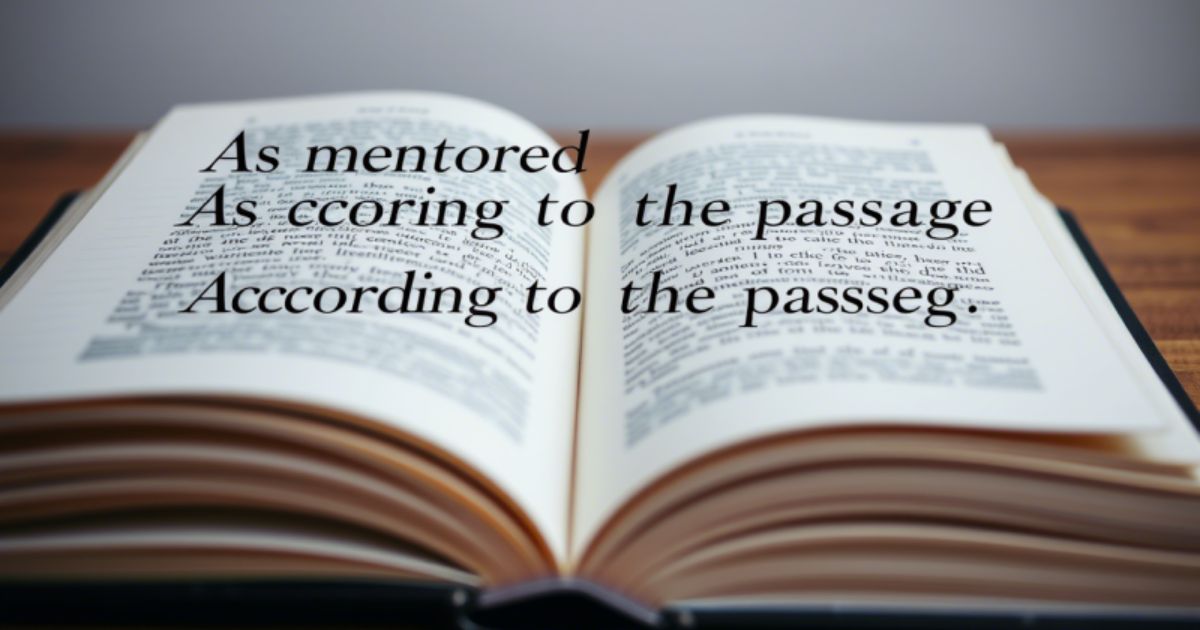When analyzing quotes, we often use the phrase “In the Text It States” to point out key ideas. Saying “In the Text It States” helps highlight specific evidence from reading material. If you’re writing an essay or answering questions, using “In the Text It States” shows you’re referring directly to the source. Many students wonder if there’s another way to say the text states. Yes, there are options, but “In the Text It States” is one of the clearest ways.
You might also use a the text states synonym like “the passage explains” or “the author mentions.” Still, in the text it states synonym choices don’t always carry the same strength. Looking for in the text synonym ideas? Phrases like “the article says” or “it is stated” can help. Yet, “In the Text It States” remains a solid choice when citing. Stick with it unless your teacher prefers another way to say the text states.
What Does “In the Text It States” Mean?
In the Text It States is a phrase used to introduce direct evidence from written content. It helps readers know that your point is based on something specific in the text. This phrase signals that your answer or explanation isn’t just personal opinion—it’s backed up by the actual words from the source material.
When to Use “In the Text It States”
You can use In the Text It States when you’re referencing or quoting information directly from a book, article, or passage. It’s especially useful in academic writing, essays, or reading comprehension tasks. This phrase helps show that you’re making a connection between your thoughts and what the original text clearly expresses.
Is It Professional/Polite to Say “In the Text It States”?
In the Text It States is both polite and professional when used in formal or academic settings. It’s commonly used in classrooms, exams, and research papers. It adds credibility to your writing and demonstrates respect for the source material. Just use it where it’s relevant and not too frequently in the same paragraph.
In the Text It States Synonyms:
1. The text mentions
2. It is noted in the text
3. According to the text
4. The document states
5. As outlined in the text
6. The author notes
7. It’s highlighted in the text
8. The text reveals
9. The text indicates
10. The passage describes
11. As mentioned earlier
12. The text outlines
13. It states clearly
14. The text conveys
15. It mentions
16. As referenced in the text
17. The information states
18. As described in the text
19. The text emphasizes
20. The content illustrates
21. It outlines
22. The text specifies
23. The writing states
24. As explained in the text
25. The document highlights
26. It reveals in the text
27. The text articulates
28. The narrative indicates
29. The report mentions
30. As found in the text
Alternative Phrases for “In the Text, It States”

- According to the passage, the main idea is clearly explained here.
- The author makes it clear in this specific part of the reading.
- This line from the text helps support the given explanation well.
- The written content mentions this idea directly in the following section.
- Here, the passage provides insight into what the writer truly means.
- We can understand the point better through this part of the passage.
- As written above, the author offers clarity on this exact issue.
- From this part of the text, we learn the important message.
Synonyms for “The Text States”
- The passage points out a key idea in this particular section.
- In this section, the writer clearly brings attention to the point.
- The content delivers a direct explanation that supports the main argument.
- It is written that this concept appears in the author’s words.
- The writer makes sure this idea stands out in the paragraph.
- The article includes a helpful line about this specific detail.
- It is clearly written in the passage for easier understanding.
- The sentence shows what the writer meant at that moment.
Other Ways to Say “As Stated in the Text”
- As mentioned earlier, the writer emphasized this point using clear language.
- The writer already shared this important detail in the paragraph above.
- From the previous line, it is obvious what the writer intended.
- The sentence earlier showed how the author developed this idea clearly.
- That specific part gives context and helps prove the writer’s point.
- The earlier words from the author highlight this important thought.
- The paragraph explains exactly how this topic is addressed by the writer.
- That line shows the author’s thoughts without any confusion or doubt.
Read Also: 35 Other Ways to Say “This Quote Shows” (With Examples)
Formal and Academic Alternatives

- The author articulates this concept within a well-developed sentence of support.
- It is evident from the passage that the point was intentional.
- The author presents this argument clearly within the selected portion of text.
- Evidence for this claim is found within the reading’s stated section.
- The reading outlines this concept with clarity and supporting details throughout.
- This segment from the reading reflects the writer’s purpose effectively and professionally.
- The point is substantiated within the reading’s direct and structured wording.
- A critical point is addressed here as stated by the author.
Casual and Conversational Alternatives
- The writer talks about this part like it’s super important to know.
- It says right here in the text what the idea means.
- The writer brings this up earlier in a pretty clear way.
- This part of the writing actually shows what’s really going on.
- We already saw that part when the author mentioned this idea.
- It’s right there in the sentence the author wrote for us.
- The words here tell us exactly what the writer was saying.
- Looks like the author made this pretty clear earlier in the paragraph.
1. The text mentions
Meaning: Refers to information included in the text.
Tone: Neutral and straightforward.
Example: “The text mentions that teamwork is essential for success.”
Definition: To indicate a specific point made in the document.
Explanation: This phrase maintains clarity while sounding more conversational.
2. It is noted in the text
Meaning: Points out a fact or detail written in the material.
Tone: Formal and passive.
Example: “It is noted in the text that safety comes first.”
Definition: Used to emphasize an observation recorded in the passage.
Explanation: Ideal for academic or official contexts needing objective phrasing.
3. According to the text
Meaning: Quotes or references something directly from the content.
Tone: Formal and accurate.
Example: “According to the text, water boils at 100°C.”
Definition: A way to cite evidence or details from a source.
Explanation: Great for supporting claims in essays and reports.
4. The document states
Meaning: Expresses something directly communicated by the source.
Tone: Objective and legalistic.
Example: “The document states all employees must wear ID badges.”
Definition: Highlights formal declarations or policies written in text.
Explanation: Common in legal, corporate, or formal documentation.
5. As outlined in the text
Meaning: Summarizes or references structured points in the content.
Tone: Organized and professional.
Example: “As outlined in the text, the plan has four stages.”
Definition: Indicates a listed or detailed part of the source.
Explanation: Works well for instructional, policy, or business writing.
6. The author notes
Meaning: Identifies a comment or statement made by the writer.
Tone: Analytical and clear.
Example: “The author notes that many species are now endangered.”
Definition: Highlights observations or key remarks by the writer.
Explanation: Useful in literary, academic, and journalistic discussions.
7. It’s highlighted in the text
Meaning: Shows emphasis on a specific detail or point.
Tone: Informative and slightly casual.
Example: “It’s highlighted in the text that punctuality improves performance.”
Definition: Brings attention to something deemed important in writing.
Explanation: Ideal for both educational and general content.
8. The text reveals
Meaning: Discloses or uncovers information within the source.
Tone: Slightly literary and insightful.
Example: “The text reveals the character’s deep insecurity.”
Definition: Indicates what becomes clear through reading.
Explanation: Often used in storytelling or analytical writing.
9. The text indicates
Meaning: Shows that the passage points to a conclusion or fact.
Tone: Formal and explanatory.
Example: “The text indicates rising sea levels are a global issue.”
Definition: Used to explain what a source demonstrates.
Explanation: Great for analysis, summaries, and technical writing.
10. The passage describes

Meaning: Offers detail or narration about a subject in the content.
Tone: Descriptive and neutral.
Example: “The passage describes the lush landscape in vivid terms.”
Definition: Used when summarizing narrative or visual information.
Explanation: Best for descriptive or literary contexts.
11. As mentioned earlier
Meaning: Refers to a point already introduced in the content.
Tone: Reflective and slightly formal.
Example: “As mentioned earlier, preparation is key to success.”
Definition: A phrase that revisits previously stated information.
Explanation: Helpful in essays to connect or reinforce earlier ideas.
12. The text outlines
Meaning: Summarizes or structures key elements in the content.
Tone: Organized and professional.
Example: “The text outlines three main strategies for improvement.”
Definition: Provides a clear structure of ideas or points.
Explanation: Great for technical, business, or instructional materials.
13. It states clearly
Meaning: Expresses something in a direct and unambiguous way.
Tone: Assertive and formal.
Example: “It states clearly that all entries must be submitted by Friday.”
Definition: Highlights precision and clarity in writing.
Explanation: Best used to emphasize firm or explicit information.
14. The text conveys
Meaning: Communicates an idea, feeling, or message.
Tone: Expressive and insightful.
Example: “The text conveys a sense of urgency and fear.”
Definition: Describes the way meaning or tone is delivered.
Explanation: Common in literary and emotional analyses.
15. It mentions
Meaning: Brings up or briefly refers to something.
Tone: Casual and straightforward.
Example: “It mentions the importance of regular exercise.”
Definition: Notes the appearance of a subject in text.
Explanation: A simplified version often used in casual summaries.
16. As referenced in the text

Meaning: Cites a specific part of the content.
Tone: Formal and academic.
Example: “As referenced in the text, policy violations lead to consequences.”
Definition: Used to refer to cited or linked information.
Explanation: Effective in scholarly writing and formal discussions.
17. The information states
Meaning: Presents factual or written content from the source.
Tone: Objective and neutral.
Example: “The information states that the company was founded in 1990.”
Definition: Refers to presented data or statements.
Explanation: Common in reports, research, or technical writing.
18. As described in the text
Meaning: Indicates how something is portrayed or detailed in the passage.
Tone: Neutral and explanatory.
Example: “As described in the text, the machine operates automatically.”
Definition: Points to written explanations or examples.
Explanation: Useful in analysis, how-to guides, and academic texts.
19. The text emphasizes
Meaning: Highlights something important or significant.
Tone: Strong and assertive.
Example: “The text emphasizes the value of hard work.”
Definition: Draws attention to key messages or themes.
Explanation: Great for persuasive or motivational writing.
20. The content illustrates
Meaning: Provides an example or visualization of an idea.
Tone: Visual and descriptive.
Example: “The content illustrates how teamwork improves productivity.”
Definition: Shows or supports a concept with examples.
Explanation: Ideal for explanations, diagrams, and teaching content.
21. It outlines
Meaning: Summarizes or presents the key points.
Tone: Clear and informative.
Example: “It outlines the steps required for registration.”
Definition: Indicates a structured list or overview in writing.
Explanation: Useful in instructional, procedural, or business documents.
22. The text specifies
Meaning: Details something precisely and explicitly.
Tone: Formal and exact.
Example: “The text specifies the required qualifications for applicants.”
Definition: Offers detailed or strict information within the source.
Explanation: Best for legal, academic, and technical writing.
23. The writing states
Meaning: Expresses an idea or fact in written form.
Tone: Neutral and factual.
Example: “The writing states that honesty builds trust.”
Definition: Refers to direct statements made in the content.
Explanation: A general phrase good for casual or formal use.
24. As explained in the text
Meaning: Indicates that clarification is provided in the source.
Tone: Helpful and instructional.
Example: “As explained in the text, the results were statistically significant.”
Definition: Refers to explanations or justifications in content.
Explanation: Great for educational or scientific materials.
25. The document highlights
Meaning: Emphasizes specific information in the material.
Tone: Assertive and informative.
Example: “The document highlights the importance of cybersecurity training.”
Definition: Draws attention to essential or priority content.
Explanation: Often used in summaries, briefs, and official reports.
26. It reveals in the text
Meaning: Uncovers or shows information found within the content.
Tone: Analytical and revealing.
Example: “It reveals in the text the true motive of the character.”
Definition: Points to hidden or deeper meanings in writing.
Explanation: Effective in literary analysis or critical reading.
27. The text articulates
Meaning: Expresses thoughts or ideas clearly and effectively.
Tone: Formal and precise.
Example: “The text articulates the vision for future growth.”
Definition: Highlights thoughtful or deliberate expression.
Explanation: Ideal for professional or academic writing with structured arguments.
28. The narrative indicates
Meaning: Shows or suggests something within a storytelling context.
Tone: Descriptive and literary.
Example: “The narrative indicates a shift in the character’s behavior.”
Definition: Refers to what the story implies or makes known.
Explanation: Best used in literature, storytelling, or creative writing.
29. The report mentions
Meaning: Briefly refers to a point or detail in a report.
Tone: Neutral and factual.
Example: “The report mentions an increase in customer satisfaction.”
Definition: Summarizes observations in official or research reports.
Explanation: Common in business, scientific, or market analysis writing.
30. As found in the text
Meaning: Refers to information that appears within the material.
Tone: Objective and precise.
Example: “As found in the text, proper planning prevents poor performance.”
Definition: Indicates content located within the written source.
Explanation: Useful for citations and text-based evidence.
FAQ’s
How do you refer to a quote when writing an answer?
You can begin your explanation with In the Text It States to show you’re using evidence. It helps link your thoughts with the source clearly.
What’s a simple way to introduce a sentence from a passage?
Start your response using In the Text It States for a smooth and strong transition. It keeps your answer connected to the original text.
How can students support their claims in school essays?
By writing In the Text It States, students show they’re citing information. It proves their ideas come from the text, not just personal opinion.
What’s a helpful phrase when answering comprehension questions?
Use In the Text It States to reference what the author said. That way, your answer sounds clear, direct, and well-supported by the text.
How should you include evidence while summarizing a paragraph?
Say In the Text It States before including a key detail. This makes it obvious you’re drawing from the actual passage, not guessing.
Conclusion
To wrap it up, using “In the Text It States” helps clearly connect your ideas to the original content. Whether you’re writing answers or essays, “In the Text It States” keeps your response focused. Many writers search for another way to say the text states, but few phrases are as direct. You could use a the text states synonym, yet “In the Text It States” remains the most effective and clear option.
If you need variety, consider an in the text it states synonym like “the author writes” or “the passage says.” These in the text synonym choices work but may not carry the same weight. Still, repeating “In the Text It States” shows confidence and supports your evidence. When quoting material, don’t overthink it stick with what works. And what works best is almost always “In the Text It States”, even if you’re tempted by another way to say the text states.

